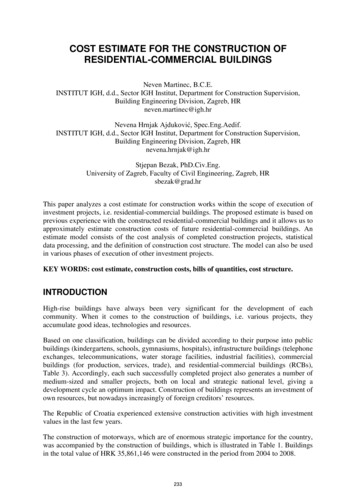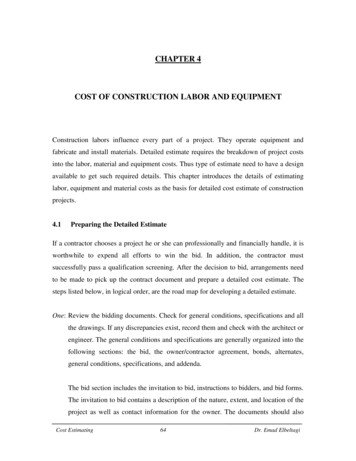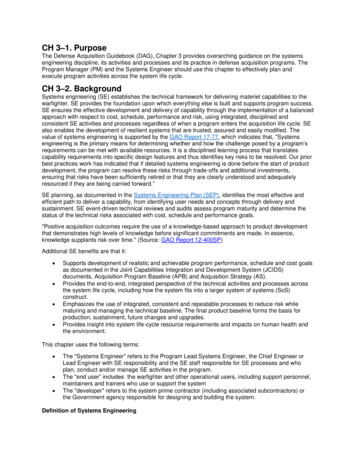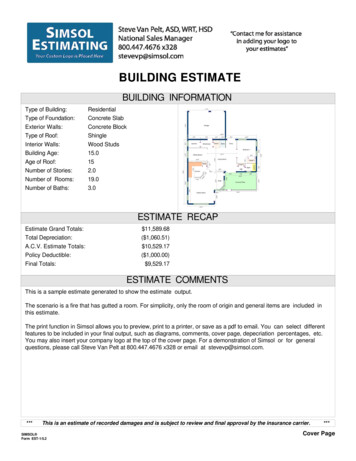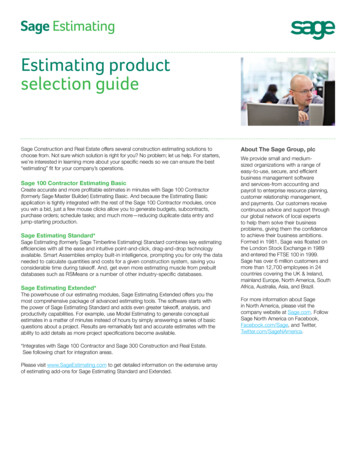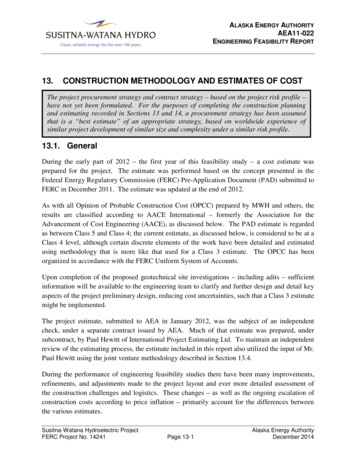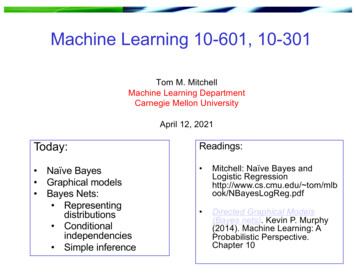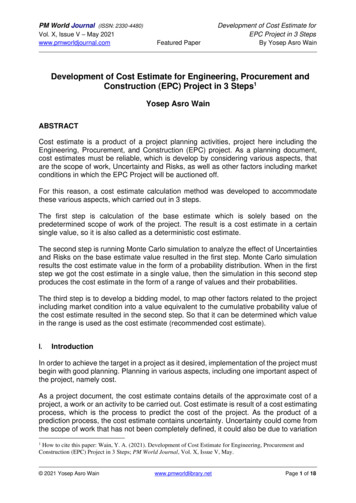
Transcription
PM World Journal (ISSN: 2330-4480)Vol. X, Issue V – May 2021www.pmworldjournal.comFeatured PaperDevelopment of Cost Estimate forEPC Project in 3 StepsBy Yosep Asro WainDevelopment of Cost Estimate for Engineering, Procurement andConstruction (EPC) Project in 3 Steps1Yosep Asro WainABSTRACTCost estimate is a product of a project planning activities, project here including theEngineering, Procurement, and Construction (EPC) project. As a planning document,cost estimates must be reliable, which is develop by considering various aspects, thatare the scope of work, Uncertainty and Risks, as well as other factors including marketconditions in which the EPC Project will be auctioned off.For this reason, a cost estimate calculation method was developed to accommodatethese various aspects, which carried out in 3 steps.The first step is calculation of the base estimate which is solely based on thepredetermined scope of work of the project. The result is a cost estimate in a certainsingle value, so it is also called as a deterministic cost estimate.The second step is running Monte Carlo simulation to analyze the effect of Uncertaintiesand Risks on the base estimate value resulted in the first step. Monte Carlo simulationresults the cost estimate value in the form of a probability distribution. When in the firststep we got the cost estimate in a single value, then the simulation in this second stepproduces the cost estimate in the form of a range of values and their probabilities.The third step is to develop a bidding model, to map other factors related to the projectincluding market condition into a value equivalent to the cumulative probability value ofthe cost estimate resulted in the second step. So that it can be determined which valuein the range is used as the cost estimate (recommended cost estimate).I.IntroductionIn order to achieve the target in a project as it desired, implementation of the project mustbegin with good planning. Planning in various aspects, including one important aspect ofthe project, namely cost.As a project document, the cost estimate contains details of the approximate cost of aproject, a work or an activity to be carried out. Cost estimate is result of a cost estimatingprocess, which is the process to predict the cost of the project. As the product of aprediction process, the cost estimate contains uncertainty. Uncertainty could come fromthe scope of work that has not been completely defined, it could also be due to variation1How to cite this paper: Wain, Y. A. (2021). Development of Cost Estimate for Engineering, Procurement andConstruction (EPC) Project in 3 Steps; PM World Journal, Vol. X, Issue V, May. 2021 Yosep Asro Wainwww.pmworldlibrary.netPage 1 of 18
PM World Journal (ISSN: 2330-4480)Vol. X, Issue V – May 2021www.pmworldjournal.comFeatured PaperDevelopment of Cost Estimate forEPC Project in 3 StepsBy Yosep Asro Wainin prices, error in cost modeling used in cost estimating process, and change in price thatmay occur before or during project execution.Executing a project is not easy, there are many factors that influence it, both external andinternal, which may have a negative impact to the project, which in the end could causetarget was set in the planning is not achieved. These factors are known as project risks.Project risks have a negative impact on the project, including a decrease in the quality ofthe work products, delays in completion of the project and an increase in the final projectcosts. Mitigation of project risks is generally always carried out, however mitigation itselfcan usually only reduce the risk, it does not eliminate the risk completely, there is alwaysa residual risk left there.In general, projects are carried out by contractors, it is very rare that a project to be doneby the owner himself. The appointment of a contractor to carry out a project is usuallydone through a bidding, which is participated by many bidders. During bidding, contractoralways adds a number of costs in addition to the base cost of the project, which dependson the current market conditions. When the market is lonely with projects, where the levelof competition is high, the contractor tends to reduce the cost of the project in order towin the competition. Conversely, when a project is in abundance in the market, thecontractor will tend to increase the bid value.Therefore, in order to obtain a reliable value, development of cost estimate for EPCproject must take into account all of the above factors, namely const estimatinguncertainty, project risks and market condition.This paper will describe process of preparing a cost estimate, especially cost estimatefor an engineering procurement construction (EPC) project in the oil & gas sector. As perthe title of this paper, preparation of cost estimate is carry out in three steps, namely thepreparation of a base estimate or deterministic cost estimate, Monte Carlo simulation toanalyze impact of uncertainty and project risks, and development of bidding model toknow the influence of market conditions (and other project related factors) to the projectcosts.II.Deterministic Cost EstimateCost estimating is a process for predicting the cost of a project, a work, or an activity. Forthe project owner, the cost estimating result, which is cost estimate, can be used forvarious purposes, including as an owner's estimate in the bidding process or as anengineering estimate for budgeting purposes or other needs.A cost estimate that is developed using a single specific value (single point estimate) forboth price and quantity of the work is referred to as a deterministic cost estimate and isused as a base estimate2.2The term “Base Estimate” here is different from term “Cost Baseline” used in the A Guide to The PMBOK 6thEdition. If in the PMBOK, the Cost Base line is defined as the Work Package Cost plus the Contingency Reserve,then the Base Estimate in this paper can be compared to the Work Package Cost, without any Contingency. 2021 Yosep Asro Wainwww.pmworldlibrary.netPage 2 of 18
PM World Journal (ISSN: 2330-4480)Vol. X, Issue V – May 2021www.pmworldjournal.comFeatured PaperDevelopment of Cost Estimate forEPC Project in 3 StepsBy Yosep Asro WainCost estimate, especially for CapEx (Capital Expenditure) estimate, is generally made inthe form of a standard structure, with each cost component being standardized as well.This standardization is useful for preventing confusing during development of costestimate and also accelerating the process of development cost estimates itself. Withstandardization of structure, it is easier to evaluate the reasonable price of eachcomponent, and to identify which component can be optimized. In addition, the standardstructure allows us to build a cost model.The following table shows one of the cost estimate standard structures that is often used.Table 1: Cost Estimate Standard StructuresDirect Costs1. Equipment Cost2.Bulk Material Cost3.Installation CostIndirect Cost1. Indirect Field Cost2.Home Office Cost3.Other CostAll costs related to the physical parts of the plant.Equipment cost including equipment allowance,freight, taxes, insurance, and duties. Equipment consistof pump, compressor, heat exchanger, tank,column/vessel, fire heater, boiler, reactor, spare parts,etc.Bulk material cost that consist of site work, concrete,structure steel, building/architectural, inting/coating, fireproofing, insulation, scaffolding,etc.Installation cost consist of labor cost for installationand material cost for structural supports, includingsetting and calibration.All costs related to non-physical parts of the plant.All costs associated with temporary constructionfacilities; construction services; supplies andconsumables; field staff and subsistence uipment/heavy lift and tools.All costs associated with project management, controlsand estimating criteria, procurement, constructionmanagement, engineering and design, and homeoffice expenses.Contractor fee dan contingency.There are a number of cost estimate method that can be used in estimating project cost.The use of certain method will depend on several things, including design maturity,purpose of estimate, project complexity, and availability of references data.In the earlier phase of the project, where the availability of information is still very limited,the method used to calculate the cost estimate is of course different from the later phaseswhere the engineering documents are more complete.AACE International Recommended Practice No. The 18R-97 describes this mater verywell in tabular form as shown in the following table. 2021 Yosep Asro Wainwww.pmworldlibrary.netPage 3 of 18
PM World Journal (ISSN: 2330-4480)Vol. X, Issue V – May 2021www.pmworldjournal.comFeatured PaperDevelopment of Cost Estimate forEPC Project in 3 StepsBy Yosep Asro WainTable 2: Cost Estimate Classification Matrix for The Process Industries3Based on the table, it can be seen that in the initial project phase, where the engineeringdeliverables were still very limited (at 0% to 15% completed), the estimation method thatused is a factored estimate, either capacity factored, parametric or equipment factored.Even if objective data are not available, more subjective methods such as analogy andjudgment can be used. As the engineering deliverable becomes more complete (at 10%to 40% completed), the estimate method used also changes to a semi-detailed unit cost,or a detailed unit cost if 75% or 100% of the engineering deliverables are available.In addition, the cost estimate method used also depends on the purpose of estimates tobe developed. For budgetary purposes, the method that used is a factored estimate, onthe other hand, if it is needed for bidding, the method that used is a semi-detailed or adetailed one. Factorized cost estimate is also often used as a comparison tool to verifythe estimate result which developing using the semi-detailed or detailed method.The level of detail in which a cost estimate is made depends on the complexity of theproject or work. For a less complex project, let say the scope is only consist of few piecesof equipment, the cost estimate can be very detailed, piping system for example, it maybe up to the level of flanges & fittings. On the other hand for complex projects, let say forbuilding a new refinery, the cost estimate made is not as detailed as the cost estimate forinstalling the equipment as mentioned above, the quantity for piping system may be madein tonnage without specifying the number of flanges and fittings.3AACE International, Recommended Practice No. 18R-97. (2011). Cost Estimate Classification System – AsAppliedin Engineering, Procurement, and Construction for The Process Industries, AACE International, Morgantown, WV. 2021 Yosep Asro Wainwww.pmworldlibrary.netPage 4 of 18
PM World Journal (ISSN: 2330-4480)Vol. X, Issue V – May 2021www.pmworldjournal.comFeatured PaperDevelopment of Cost Estimate forEPC Project in 3 StepsBy Yosep Asro WainThe estimate method used also depends on the availability of price data, whether in theform of in-house data, or commercial data base or vendor quotation. The use of theseprice data references must first be adjusted to the project requirements, such as the sizeof the equipment, the project location, and the project schedule. Particularly for the pricereference from vendor (vendor quotation), the terms and conditions need to beconsidered, to ensure that these terms and conditions are in line with the projectrequirements.III. Uncertainty and Risk.Before discussing further as to cost estimate and its relationship with uncertainty, risk,and the market, we will first discuss the terms of uncertainty and risk considering thatthere is some confusion within the cost estimating profession regarding with both terms.Most of them equate these two terms, so that their usage is often interchangeable.I begin this discussion by citing the definition of risk stated in ISO 31000: 20184, in whichrisk is defined as the effect of uncertainty on objectives. From this definition it is clear thatthe trigger for occurrence of risk is uncertainty. Every risk must be (the effect of)uncertainty, but not all uncertainty is a risk. The world is full of uncertainties, every daywe are faced with tens, hundreds or even thousands of uncertainties. Does this meanthat we are automatically faced with thousands of risks? Of course, it does not; when wecreate a risk register for a project, for example, what is listed as risk is at most 10 to 20items. This is because that of the many uncertainties that exist, those that fall into therisk category are just those that have an impact on (the objectives of) the project.An uncertainty can be a risk for one person and not for others. Will it rain this afternoon?It could be "yes", it could also be "no", it is an uncertainty. For John who would being athome, he doesn't care whether it would rain or not. For him, raining or not in theafternoon, it will remain as uncertainty, not turn into a risk. However, for Jack whoeveryday walks to the office, this is a risk. Therefore, in his backpack, there is always anumbrella as a mitigation measure.The impact of risk can be estimated by multiplying the probability (probability ofoccurrence) by the impact. The probability of each risk has a value between the range of0 - 1, which means that the risk may or may not occur. In fact, there are also types of riskthat will definitely occur (probability value is 1), an example of this type of risk is theinherent error that exists in each cost model which affects the resulting cost estimatevalue. This error must exist, it's just that its value cannot be known for sure, all we cando is to estimate the value. Another example is the incompleteness of the projectdefinition (let say, in the BED or FEED phase, even in the DED phase), which affects thecost estimate value.4ISO 31000:2018, Risk Management – Guideline; is a standard that contains guidelines for implementing riskmanagement in the organization. 2021 Yosep Asro Wainwww.pmworldlibrary.netPage 5 of 18
PM World Journal (ISSN: 2330-4480)Vol. X, Issue V – May 2021www.pmworldjournal.comFeatured PaperDevelopment of Cost Estimate forEPC Project in 3 StepsBy Yosep Asro WainBoth types of risk must be distinguished, because they are handled differently. Forsimplicity, for the first type of risk we just call it Risk (with a capital R to distinguish it fromrisk in general), while the second type we call Uncertainty (with a capital U, to distinguishit from uncertainty in general).Similar discussion related to this topic has been carried out by Knight5. According toKnight, there are two different types of uncertainty, the first is called measurableprobability which is labelled as Risk. The second is still referred to as Uncertainty wherethe probability cannot be measured (unquantifiable ambiguity)6. This means that all risksof unknown-unknown and known-unknown types are also included in the Uncertaintycategory [please refer to next section for the explanation of the types of risk].Apart from Knight, a similar explanation also was made by Melvin7 and Dale8. Accordingto Melvin, a Risk is a discrete event with a probability of occurrence. The Risk effect(impact) is only felt if/when the event occurs. On the other hand, there is no probability ofoccurrence with an Uncertainty, you know that you don’t know the actual value of theinput variable.What needs to be interpreted from Melvin's explanation is that Risk is a discrete eventthat has a probability, may or may not happen. On the other hand, Uncertainty is not adiscrete event so it has no probability (if probability is applied then the value is 1), in thesense that it will definitely happen. Melvin's explanation is similar to Dale which explainsthe difference between Uncertainty and Risk in the form of a probability and impact tableas shown in the following table.Table 3: Probability and Impact Matrix by DaleTerminology5Probability of occurrenceBaseline100%Uncertainty100%Risk 100%ImpactCost or HoursScheduleDeterministicestimate Deterministicestimate(Most Likely)(Most Likely)Three point estimate Three point estimate(Min-ML-Max)(Min-ML-Max)Three point estimate Three point estimate(Min-ML-Max)(Min-ML-Max)Knight, F H. (1921). Risk, Uncertainty and Profit. New York, USA: Dover Publication.6It is adapted from Mundir A. H. (2018). Understanding Risk and Uncertainty in Project Management; EuropeanJournal of Economics, Law and Politics, ELP; March 2018 Edition, Vol.5, No 1.7Melvin R. Etheridge, Jr. Risk vs Uncertainty, What’s the Difference? Presented at the 2016 ICEAA ProfessionalDevelopment & Training Workshop. By using a reference from “The American Heritage Dictionary, SecondCollege Edition”, and by taking the context of the management program, Melvin R.E, Jr distinguishes the terms riskand uncertainty as follows: A Risk is a discrete event with a probability of occurrence. The Risk effect (impact) is only felt if/when theevent occurs. There is no probability of occurrence with an Uncertainty – you know that you don’t know the actual value ofthe input variable.8Dale Shermon (2017). Uncertainty and Risk: defined through probability and impact!. Refer defined-through-probability-impact-dale-shermon 2021 Yosep Asro Wainwww.pmworldlibrary.netPage 6 of 18
PM World Journal (ISSN: 2330-4480)Vol. X, Issue V – May 2021www.pmworldjournal.comFeatured PaperDevelopment of Cost Estimate forEPC Project in 3 StepsBy Yosep Asro WainIn addition to the two terms Uncertainty and Risk, Dale also added one more term,namely Baseline.The Baseline is an acknowledged activity to be conducted; it is required to complete thework package and as such is essential to the project. The probability of the projectconducting this activity is 100%, it’s part of the project, an essential step to completion,and it’s possible to assign a resource (cost) or duration (schedule) impact necessary toconduct this baseline activity.The Uncertainty is similar to the Baseline, as it has a probability of 100%, due to the needthat the project requires this activity. The difference here is that the resources (cost) orduration (schedule) is defined using a three-point estimate or a range.In case of Risk, the calculation of resources (cost) and duration (schedule) is the sameas Uncertainty, namely using a three-point estimate, while the probability is less than100%.IV. Uncertainty in Cost EstimateUncertainty always exists in the cost estimate, it arises because of the inherentinaccuracy (inherent error) in the methodology used during preparing the cost estimate,especially in the cost model. For example, in pricing a piece of equipment, say a pump,by using the reference price from the previous project (in-house data), to adjust to thecurrent conditions, the reference price must first be multiplied by one or more factors, forexample the sizing factor if the size is different, the location factor if the project locationis different, the escalation factor for correcting the project time, the material factor if thematerial type is different, and other factors. The value of these factors is obtained bystatistical methods from the data set, where the results always have errors.The use of a more updated reference price, namely from the vendor quotation is also thesame. If we get quotation prices from several vendors, these prices are never equal, thisshows that the quotation price also contains uncertainty.In a project scale, the use of the factor (equipment factor) to calculate other costcomponents of the equipment price, such as the Lang, Happel, Hand, Hackney, Guthriefactor, etc., or the use of the capacity factor to calculate the price of a process unit alsocontains uncertainty. These factors are also derived by using statistical methods whichhave errors.Uncertainty itself means the absence of certainty, so that the uncertainty value is not asingle number (point value), but it is random in a certain range. The most appropriate toolfor analyzing it is by using a Monte Carlo simulation. 2021 Yosep Asro Wainwww.pmworldlibrary.netPage 7 of 18
PM World Journal (ISSN: 2330-4480)Vol. X, Issue V – May 2021www.pmworldjournal.comV.Featured PaperDevelopment of Cost Estimate forEPC Project in 3 StepsBy Yosep Asro WainProject Risk and Cost EstimateProject risk could have an impact on project objectives including project costs. In general,project risk can be grouped into 4 (four) types which are described in the form of aquadrant model. In the quadrant model, there are two aspects to be seen, namely“identification” and “certainty”9, as shown in the following table 10:Table 4: Risk Classification MatrixCertaintyCertain (known)Uncertain (Unknown)Identified (known)Known – Known(Identified Knowledge)Known – Unknown(Identified Risk)Unidentified (Unknown)Unknown – Known(Untapped Knowledge)Unknown – Unknown(Unidentified Risk)IdentificationIn above table, if the nature of an event is certain, it is more like a fact or knowledge. Itcould be what we already know, i.e., known known, or what we don't know yet, i.e.,unknown known. If the nature of an event is uncertain, the occurrence can be uncertain,i.e., probability of occurrence is less than 1, and the impact can be uncertain as well11.All risks that have been correctly identified and measured properly fall into the knownknown category. There are risks that we already know because they have been wellidentified, but cannot be measured accurately, this type of risks is included in the knownunknown category. There are also risks that could not be measured and even the risksthemself could not be properly identified. This type of risk is included in the unknownunknown category.The last type of risk, namely unknown-known, is very rare, but that does not mean it doesnot exist. These are things that exist and have been influencing our life and our approachto reality, but we are unaware of knowing them, or we do not realize their value, or worstwe refuse to acknowledge knowing them12.9Risk classification can also be based on aspects of occurrence and impact, i.e. known-known (knowledge);unknown-known (untapped knowledge); known-unknown (risk); unknown-unknown (unfathomable uncertainty)10Kim S.D. (2012). Characterizing Unknown Unknowns. Paper Presented at PMI Global Congress 2012 – NorthAmerica, Vancouver, British Columbia, Canada. Newtown Square. It is cited sea-disputes/ . In this website, the author tried to describe the disputes in the South China Seausing the known-known, known unknown, unknown and unknown known approach. He quoted Slavoj Zizek, aSlovenian Marxist philosopher, that what is most important to mankind is what he calls “unknown knowns”.Furthermore he explained that these are things that exist and have been influencing our life and our approach toreality, but we are unaware of knowing them, or we do not realize their value, or worst we refuse to acknowledgeknowing them. These things fall into the unknown-known category. To illustrate this thing, he took the case ofASEAN's position in the South China Sea dispute, especially in relation to competition between China and the USA. 2021 Yosep Asro Wainwww.pmworldlibrary.netPage 8 of 18
PM World Journal (ISSN: 2330-4480)Vol. X, Issue V – May 2021www.pmworldjournal.comFeatured PaperDevelopment of Cost Estimate forEPC Project in 3 StepsBy Yosep Asro WainTo reduce its impact on the project, all these risks need to be managed, namely byidentifying and understanding project risk, especially for risks included in the knownunknown and unknown-known categories, and trying to shift them into the first category,known-known.The first step in risk management is to identify risks by developing a project risk register.The risk registers also include probability and consequences for each risk. By usingprobability and impact, risk is categorized based on its level of significance. For highsignificant risks, it will be completed with mitigation action to reduce the significant levelbecome lower. Any costs incurred in connection with the mitigation program are includedas a component of project costs and are part of the deterministic base estimate.Mitigation cannot eliminate all risks; this activity can only reduce risk to a certain levelcalled residual risk. This residual risk also needs to be accommodated in preparing thecost estimate which is carried out through the Monte Carlo simulation.VI. Market Condition and Cost Estimate.One method to accommodate Uncertainty and Risk in the cost estimate is through theMonte Carlo simulation. Result of Monte Carlo simulation is total project costs in the formof ranges on the probability distribution graph. Base (deterministic) estimate is only onepoint in the range.In general, the value to be used as formal cost estimate is at P50 (50% probability) whichis almost always greater than the base estimate, so that to get the P50 figure there needsto be an additional cost component that is added in the base estimate, which is commonlyreferred to as the contingency.Are we sure with this P50 value? For the project owner who is going to bid his project,this is an important question that must be answered.If the cost estimate is too low, the bidding process may fail, and the owner will lose a lotof time to re-bid. On the other hand, if the cost estimate is too high, the project maybecome unfeasible.He explained that at the national level, individual ASEAN Member States may be pro-China, or pro-US, or sitting onthe fence. But when they come together as a group in ASEAN, they say they will try to keep ASEAN neutral andconstructive. They want ASEAN to be the center of dialogue and cooperation, friendly to all major powers. Thequestion is how effective can ASEAN neutrality and centrality be? And for how long? Will the China-US rivalrycause a serious split in ASEAN, or worse a breakup of the 47-year-old organization? This is a concern that mostASEAN Member States do not even want to think about, this is an unknown known.Another unknown known is the continuing failure of EAS Leaders to help address the various island disputes. Apartfrom the South China Sea case, there are disputes between China and Japan over Diaoyu/Senkaku, between Japanand the RoK over Takeshima/Dokdo, and between Japan and Russia over the Northern Territories/Kurils. Theseisland disputes are sources of tensions, which can create instability. But they seem to be an unknown known to mostof the EAS Leaders. 2021 Yosep Asro Wainwww.pmworldlibrary.netPage 9 of 18
PM World Journal (ISSN: 2330-4480)Vol. X, Issue V – May 2021www.pmworldjournal.comFeatured PaperDevelopment of Cost Estimate forEPC Project in 3 StepsBy Yosep Asro WainIn addition, in certain bidding procedures, a cost estimate that is too high will make theowner's bargaining position to become weak.Up to this point, our attention is on the market conditions of the project which influencethe contractor to decide whether to bid or not bid; and if they decided to bid, what is thebid figure.Many studies, related to the factors that influence the contractor's decision to bid or notbid including determining the amount of the markup on the bid price, have been carriedout. One of these studies was carryout by Wang13. Based on the interviews with twosenior Taiwanese government officials, Wang concluded that there are several factorsthat influence the price of a project (ceiling price), which are grouped into 3 (three)categories, as ator’s accuracyHistorical bidding ratioMarket conditionsTendering urgencyBudget tightnessAvoiding controversyBidder’s qualificationsProject durationProject complexityAfter knowing the factors that influence the contractor's decision to bid or not bid, furthera model for determining the target cost estimate (bidding model) is developed by usingthese factors. Regarding the bidding model, many techniques have been developed tobuild the model, including modeling using utility theory, Fuzzy Logic, Neural Network,multi criteria decision, statistical regression, etc. In his paper, Wang uses utility theory todevelop a bidding model.Utility Model for Determining Cost Estimate.The utility theory was originally used in economics to quantify a person's preference fora product, either in the form of goods or in the form of services.Utility theory provides a methodological framework for the evaluation of alternativechoices made by individuals, firms and organizations. Utility refers to the satisfaction thateach choice provides to the decisionmaker. Thus, utility theory assumes that any decisionis made based on the utility maximization principle, according to which the best choicesthe one that provides the highest utility (satisfaction) to the decision maker14.13Wei-Chi Wang “SIM-UTILITY: Model for Project Ceiling Price Determination”; Journal of ConstructionEngineering and Management; January/February om/management/Tr-Z/Utility-Theory.html 2021 Yosep Asro Wainwww.pmworldlibrary.netPage 10 of 18
PM World Journal (ISSN: 2330-4480)Vol. X, Issue V – May 2021www.pmworldjournal.comFeatured PaperDevelopment of Cost Estimate forEPC Project in 3 StepsBy Yosep Asro WainApart from determining preferences in the economic field, utility theory can also be usedin other fields as long as it is still related to individual or organizational preferences, oneof which is in determining the cost estimate value.Development of the Utility Model for Determination of Cost EstimatesThe use of utility theory in determining owner estimate is carried out through a
and estimating criteria, procurement, construction management, engineering and design, and home-office expenses. 3. Other Cost Contractor fee dan contingency. There are a number of cost estimate method that can be used in estimating project cost. The use of certain method
